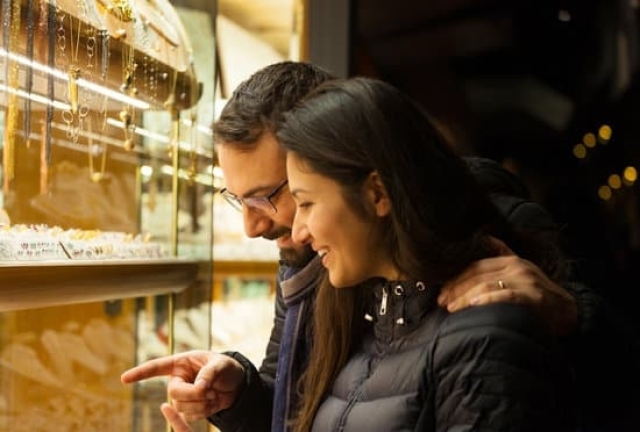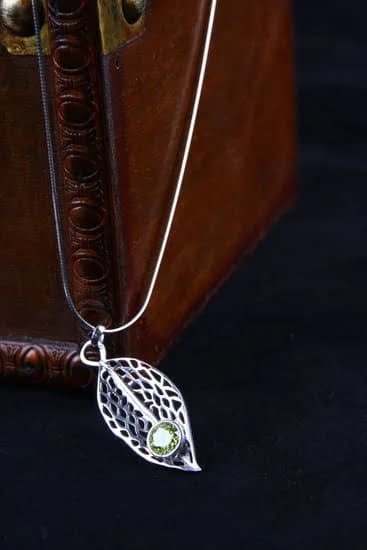Jewelry care in winter is vital to maintaining your jewelry pieces. By taking a few extra steps to properly store and protect your precious and semi-precious items, you can help keep them looking their best even during the coldest months of the year. Not only will properly caring for your pieces help you keep them in top condition, but it can also prolong the life of each piece and allow you to enjoy them for many years to come.
One important tip when it comes to jewelry care in winter is to always store pieces away from direct sunlight exposure. Sunlight can cause metals, gems, and beads to become dull over time, leading to discoloration or fading. If possible, try storing your items in a cool, dark place such as a jewelry box or a drawer that is away from any source of light. This will help preserve your pieces so they stay looking their best year-round.
Another tip when it comes to jewelry care in winter is to be mindful of how much moisture each item experiences. In areas with higher humidity levels, pieces may be more likely to tarnish or rust due to exposure from moist air or snowflakes that make contact with the metal surface.
To avoid this issue, it’s best practice to regularly wipe down your pieces with a soft cloth after wearing them outside and use cotton swabs for crevices on intricate designs which may be more prone accumulating moisture buildup over time.
Types of Jewelry
In the winter season, it’s important to take extra care of your jewelry. Different types of jewelry have different needs when it comes to protecting them from cold temperatures and moisture.
One popular type of jewelry is gold jewelry, which can range from 10k-24kt in purity. Gold can tarnish in the winter due to both wetness and low temperatures if not maintained properly.
The best way to protect gold pieces during the winter is by storing them away in a safe, dry place where temperatures are moderate and consistent. If there is any noticeable water damage or oxidation on your gold jewelry, it should be professionally cleaned and restored before being worn again.
Silver jewelry, similar to gold, will experience tarnishing if exposed to water and cold air for extended periods of time. Silver should also be stored away in a secure place with minimal fluctuating temperatures when not being worn. Unlike gold, silver can easily be polished at home without professional care – simply rubbing a cloth with silver polish over the tarnished areas or using a silver cleaning solution should effectively remove discoloration or oxidation from your silver pieces before wearing them.
Pearl and gemstone jewelry typically do not require any special storage needs other than occasional cleaning with a soft damp cloth for sparkling shine. However, due to their delicate materials, extreme temperatures can cause shrinkage or further damage any loose settings or weak bonds holding gems in place.
To ensure winter protection for stone-embellished jewels like pearl necklaces and diamond rings, store them safely in soft linens or velvet pouches so they won’t rub against each other while resting inactive until use – this will also stop them getting scratched by neighbouring surfaces while they’re inside a box or drawer.
Store Jewelry Properly
During the winter season, it is extremely crucial to care for one’s jewelry properly. This can prevent damage from moisture and unexpected freezing, which in turn will keep your jewelry looking good as new and ready to be seen.
When storing jewelry in the wintertime, you want to make sure that it is placed in a dry environment at room temperature. This could mean opting for a closed drawer, countertop case or velvet lined box with holes on the exterior walls to allow any moist air out of your storage area or container.
You also want to ensure that jewelry pieces do not come into contact with each other as they may tear or scratch due to the cold weather. Jewelry bags are ideal options when storing multiple pieces of jewelry at once, while divided compartments help when storing special items separately.
Aside from proper storage locations, jewelry owners should also address dampness and condensation issues in their home or wherever they are keeping it. Maintaining stable humidity levels inside a home or within an area where jewelry is stored is essential; however, sometimes this can be hard if living in particularly humid climates during the winter months.
Utilizing a dehumidifier can help decrease relative humidity if needed and ultimately will protect your beloved pieces from rusting due to prolonged exposure to moisture from day-to-day activities such as showers and dishwashing. If dehumidifiers aren’t available then opt for sealing your containers and boxes with plastic wrap around them since this helps reduce airflow exchange between environments, though this isn’t necessarily recommended for short term storage as some jewels require air circulation for upkeep purposes.
Treating your jewelry properly in the wintertime is key-after all proper maintenance now translates into long-lasing wearability down the line.
Clean Your Jewelry
Winter weather can be hard on jewelry, with cold temperatures and the dry air that often accompanies winter. To make sure your precious metals, gemstones and beads stay in prime condition during this season, it’s important to give them extra maintenance.
Cleaning your jewelry properly is a must for keeping it looking like new year round but it’s even more important in winter. As temperatures drop, jewels can get brittle and goods oxide faster due to humidity levels going from one extreme to another in just a quick turnaround.
When cleaning your jewelry during the cold months, it is best to use lukewarm water instead of hot water. While hot water may tend to work better on dirt and debris that has been stuck over time on the wrong materials, it can cause damage such as increasing brittleness or warping any sort of gold plated items you might have.
The ideal temperature for cleaning is around room temperature or slightly warm water that doesn’t shock the material when cleaning.
If you don’t feel comfortable using plain lukewarm water then a combination of mild dishwashing liquid and warm water should do the trick. Just remember not to use any products or materials containing chemicals or abrasives which would be too harsh for your pieces no matter what season you are in at the moment.
Cleaning cloths should also be considered carefully in winter, as some may contain harsh ingredients such as harsh soaps and detergents which could further damage our precious jewelry pieces if used improperly – especially during winter.
It is best to opt for either duster cloths designed specifically for jewelry (which are usually made from fine microfiber) if available nearby or a soft cotton cloth that has been soaked in lukewarm water with gentle detergent before wiping clean – taking note to rinse off all soap residue so there is nothing left on the pieces.
After washing your jewelries thoroughly , make sure they are completely dry before stashing them away as moisture can lead to tarnishing over time – – leaving us with rusty looking items come springtime (so no cutting corners. ).
Protect Your Jewelry
In winter, the colder temperatures and dampness can be hard on jewelry. Jewelry made of metals such as gold, silver, or brass can tarnish, dull, and rust when exposed to bitter cold and moisture. To protect your jewelry this winter season, it is important to follow a few simple steps.
It might seem counterintuitive but try not to get it wet – water can cause metal to corrode more quickly and a tarnish can form. Try not to wear jewelry while performing outdoor activities such as shoveling snow, sledding, or sledding in snowy areas.
Similarly, avoid wearing jewelry outdoors during rain or snow storms as the combination of cold weather and water could damage it. Even when inside the house during colder months keep an eye out for condensation near windows or radiators – this kind of external moisture tends to seep into metal settings and weaken them over time.
For additional protection against winter’s harsher temperatures you could use preventative home remedies such as storing your jewelry in moist proof bags with desiccants (which absorb moisture) like small packets of silica gel.
You can also wiped down your pieces with a soft cloth dampened with vinegar before placing them back into storage boxes so that any dust attached will be released from tiny cracks in the stones – dust can act as mini magnifiers when exposed to sunlight causing heat spots on your jewels surface which is definitely something you want to avoid.
Although these methods work great for simple maintenance of your jewels during an extended period away from you during cold months, regular cleaning routine would still be highly recommended for full preservation purposes at least once a year if possible even during off-seasons too.
Some cleaning solutions available that are intended specifically for metals like gold should help take care of oxidation buildup from daily wear if necessary – just make sure NOT use them too abrasively on softer stones/gems that may scratch easily.
Remove Jewelry Before Winter Activities
It is important to remove jewelry before participating in winter activities such as skiing, snowboarding, sledding, and ice skating. These activities require you to move quickly and with a great range of motion, which could potentially cause damage to the delicate metals and stones. Rings can easily catch on skis or when wearing gloves/mittens while sliding down a hill, making them more susceptible to bending and breaking.
Necklaces are also easily caught on sweater collars or snagged on outerwear zippers. There is a chance that the pendant could become detached from the rest of the necklace and fall off during the course of these activities. Even if chains are made out of strong materials such as gold or silver, they can snap if pulled too hard from catching onto something during winter sports.
It is best to leave jewelry at home before going outside for any type of winter activity. This will protect it from accidental breakage or loss due to being caught on something during any movement involved in these types of activities-a measure that no one wants to have to take but one that is necessary for proper maintenance and protection nonetheless.
For those who still want a bit of sparkle when outdoors in colder months-a warm wool hat or knitted scarf sprinkled with rhinestones can offer just enough glitz without running the risk of damaging expensive jewelry items
Wherever possible, your jewelry should be kept indoors away from harsh temperatures and changing weather conditions that may bring moisture into contact with your pieces. It’s especially important not to wear jewelry while sleeping since this gives body heat an opportunity to cause oxidation discoloration, tarnishing metals and dulling stones When taking your pieces off, make sure they’re put back into their respective cases so that ambient humidity doesn’t damage them further.
For everyday life there are many cheater rings (or style rings) available from local stores or online retailers; fashionable substitute pieces provide an affordable alternative for when heading out in cold weather conditions is unavoidable-and taking valuable gems off isn’t an option.
Remove Jewelry Before Bedtime
Removing jewelry before going to bed is especially important during the wintertime, when extra layers of clothing and blankets make it even easier for jewelry to catch and snag on fabric. Not only can this cause damage to the items themselves, but it can create a safety hazard if fastening clasps suddenly become undone in the night or the piece of jewelry gets hooked around an extremity.
Taking off your jewelry before getting into bed is also beneficial because swimming pools and hot tubs tend to be heated during the winter months, creating an environment where you could lose precious jewelry without even knowing it. Additionally, some activities such as weight lifting are more risky with most types of jewelry still attached as they can lead to breakage if strain is placed on them.
Storing Jewelry Properly: Knowing how to store your different pieces of jewelry properly will in turn help you protect it year-round, including during winter time
It’s essential to store your valuable pieces in a protective way so as to minimize any potential damage from external elements that may occur while they’re not in use. For example, items made from gold should always be kept clean by avoiding contact with chemicals or perfumes directly on the metal surface, and should preferably be stored away in individually sealed bags or airtight containers along with a desiccant packet if possible.
Silver bracelets tend to tarnish quickly during periods of extreme cold weather due to increased condensation levels happening within sealed containers, so consider adding a small pouch filled with anti-tarnishing paper material alongside any other specific instructions given by a jeweler/ retailer when making any purchase.
Finally, fragile gems need extra special care – hence why storing them inside velvet lined trays or padded boxes is ideal in order maintaining their delicate nature correctly through regular wear and tear over time.
Clean Jewelry Thoroughly: Keeping dirt at bay is extremely important for preserving the integrity of all the different types of materials you may have come across
A clean piece of jewelry shines brighter and lasts longer than one neglected over time – making regular cleaning one of the most convenient ways for ensuring its vitality throughout winter months versus leaving it feeling grimy and lackluster afterwards. The most effective maintenance method for anyone owning precious metals such as white gold or rose gold include warm water + washing up soap (not hand soap) when soaked slowly overnight – but never submerge any item decorated with diamonds.
There are also many reputable cleaning agents available such as mild detergents + polishing cloths which work great depending on what type of stone had been used in its entirety thereon (e.g emeralds generally require milder solutions due to their extreme sensitivity).
Furthermore, sunlight has been known increase luster + vibrancy which jewellery needs every once in a while – but keep in mind that over exposure can discolour stones pretty quickly though, so perform quick inspections if placing outside unprotected even briefly just in case.
Take Jewelry to a Professional Jeweler
In the winter months, taking your jewelry to a professional jeweler is important for regular checkups and maintenance to ensure that all pieces are in good condition before the season starts. Not only does this help prolong the life of your jewelry, but it also provides you with an extra layer of protection from potential damage or loss due to certain weather hazards.
From ice and snow to winds and freezing temperatures, winter weather can be hard on jewelry pieces. Precious metals such as gold or silver can corrode, diamonds can lose their luster or even crack under stress, and some gems may change color or become brittle if exposed to cold for too long.
A routine check-up by a professional jeweler before the colder months arrive will help identify any signs of wear or tear so that minor repairs can be taken care of before they become more serious issues requiring substantially higher costs down the line.
When it comes to protecting jewelry during the winter months, many people believe that taking them off and putting them away until spring is the best option. However, while this is certainly a suggested practice for rings in particular due to their size and weight, bracelets, necklaces, earrings and other items should still be treated gently when worn but need not necessarily be stored away faraway.
They may just have to have extra TLC such as cleaning products made specifically for natural stones like pearls or turquoise which will save them from becoming dry or fading over time.
Additionally, most professionals advise against wearing certain gemstones like opals in general when it’s cold outside (or even at home) as it can easily cause cracks in these delicate specs due to temperature fluctuations. A professional jeweler will know what type of temperature extremes your jewelry pieces should endure during winter months so that you don’t needlessly put yourself at risk for expensive repairs efforts later on down the road.

Welcome to my jewelry blog! My name is Sarah and I am the owner of this blog.
I love making jewelry and sharing my creations with others.
So whether you’re someone who loves wearing jewelry yourself or simply enjoys learning about it, be sure to check out my blog for insightful posts on everything related to this exciting topic!





